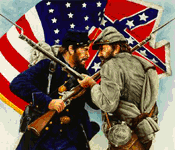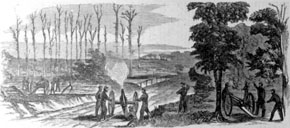 |
Civil War Battles |
|
State War Records |
| AL - AK - AZ - AR - CA - CO - CT - DE - FL - GA - HI - ID - IL - IN - IA - KS - KY - LA - MA - MD - ME - MI - MN - MS - MO - MT - NE - NV - NH - NJ - NM - NY - NC - ND - OH - OK - OR - PA - RI - SC - SD - TN - TX - UT - VT - VA - WA - WV - WI - WY |
The Battle of Raymond
May 12, 1863 in Raymond, Mississippi
 |
|||||||||||||||||||||
|
Following the Union victories at Grand Gulf and Port Gibson, Maj. Gen. Ulysses S. Grant moved his army in a northeasterly direction toward Raymond, using the Big Black River to protect Maj. Gen. John A. McClernand's corps on the Union left. Maj. Gen. William T. Sherman was in the center and Maj. Gen. James B. McPherson on the right. Grant planned to strike the Southern Railroad of Mississippi between Vicksburg and Jackson and isolate Vicksburg by cutting Lt. Gen. John C. Pemberton's supply and communications line.
On May 11, McPherson's 12,000 thirsty Union soldiers were trudging towards Raymond from their camp at Weeks' farm, 4 miles past Utica along the Utica-Raymond Road. The Federals marched only 1 1/2 miles that day, encamping at Roach's farm on the road to Raymond. Roach's was only 1/2 mile from the waters of Tallahala Creek, and the parched soldiers needed water. On the same day, Brig. Gen. John Gregg's brigade of 3,000 Confederates marched into Raymond around 4:00 P.M. from Jackson. Ordered by Lt. Gen. John C. Pemberton, commander at Vicksburg, Brig. Gen. John Gregg led his force from Port Hudson, Louisiana, to Jackson, and out to Raymond to intercept approaching Union troops.
On May 12, McPherson's men were rousted out of their sleep at Roach's farm at 3:30 A.M. so that they could arrive in Raymond per Grant's order. As they were trudging through the dust from Roach's to Raymond, Brig. Gen. John Gregg was making a fateful decision for his much smaller force of 3,000. Before dawn, McPherson had his XVII Army Corps on the march.
By 10:00 A.M., McPherson's XVII Corps were about 3 miles from Raymond. They were marching along the Utica Road southeast of Raymond in the valley of Fourteen-mile Creek when it's skirmish line was suddenly hit by the deadly fire of Gregg's battle-hardened Confederate brigade. The 3 guns of Capt. Hiram Bledsoe's Missouri battery, positioned to cover the bridge across the creek, also opened fire on the Federals at a range of 1,000 yards.
Gregg's scouts had only seen the lead brigade of McPherson's ever-lengthening column comprised of 2 Union divisions, hence the gross underestimate of the Union strength. Gregg was not about to fall back, especially if he thought he was facing only one Union brigade. Ironically, he decided to set a trap for this "marauding excursion." He would lure the Union army forward on the Utica Road by placing a regiment in a blocking position where Fourteen Mile Creek flowed under a wooden bridge, about 2 miles south of Raymond. The remainder of his men would be placed in positions to support the advanced regiment, to spring the trap, and to ensure that no other Union forces were approaching on different roads.
Two regiments were placed on the lower Gallatin Road, which ran almost parallel to the Utica Road and about 1 mile to the east. These 2 Tennessee regiments, at the appropriate time, were to swing westward to hit the Union right flank as the Federals attacked the blocking position at the bridge on the Utica Road. Gregg intended to bag the perceived Union brigade.
The trap was set, an effective trap for a large Confederate brigade of about 3,000 soldiers attacking a smaller Union brigade of about 1,500 men. However, it was a formula for an impending Confederate defeat when poor intelligence failed to identify the Union force as over 12,000 soldiers with 22 cannon. As the Federals approached, the Confederates opened fire, initially causing heavy casualties. Some Union troops broke, but Maj. Gen. John A. Logan rallied a force to hold the line. Logan's stand had bought the time needed for additional Union regiments to rush into line, and the tide of battle began to turn.
Confederate troops attacked the line but had to retire. More Union troops arrived and they counterattacked. Heavy fighting ensued that continued for 6 hours, but the overwhelming Union force prevailed. In such situations, events usually go from bad to worse. Gregg experienced this when 1 of his 3 cannon, a relatively rare English Whitworth breech-loading rifle, burst at the muzzle. Gregg eventually realized he had grossly underestimated the size of the Union force, and by 4:00 P.M. ordered his commanders to retire from the field. Gregg's men left the field.
Although Gregg's men lost the battle, they had held up a much superior Union force for a day. Despite the 4-to-1 Union odds, the Confederates obtained initial success due to the Union officers' difficulty in maneuvering their regiments into line from the corps-long column that snaked its way along the road from Utica.
The Battle of Raymond looms large in history. The change in the operational situation after Raymond resulted in a change of Grant's scheme of maneuver in the Vicksburg Campaign. He boldly changed his decisive point from the Southern Railroad near Edwards to the capital city of Jackson. He made an audacious decision to attack 1 force at Jackson while turning his back on another at Edwards. As soon as Jackson fell, he resumed the offensive by attacking and defeating Pemberton at Champion Hill, Big Black River, and Vicksburg. Maj. Gen. Ulysses S. Grant could never have read Clausewitz, but he innately understood that, "Reducing an enemy fortress does not amount to halting the offensive."
The Battle of Raymond stands as a pivotal point in the most brilliant campaign ever fought on American soil.
